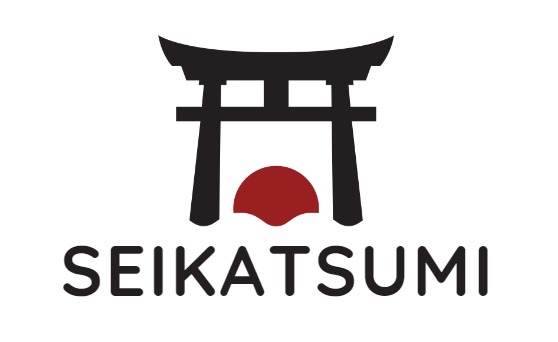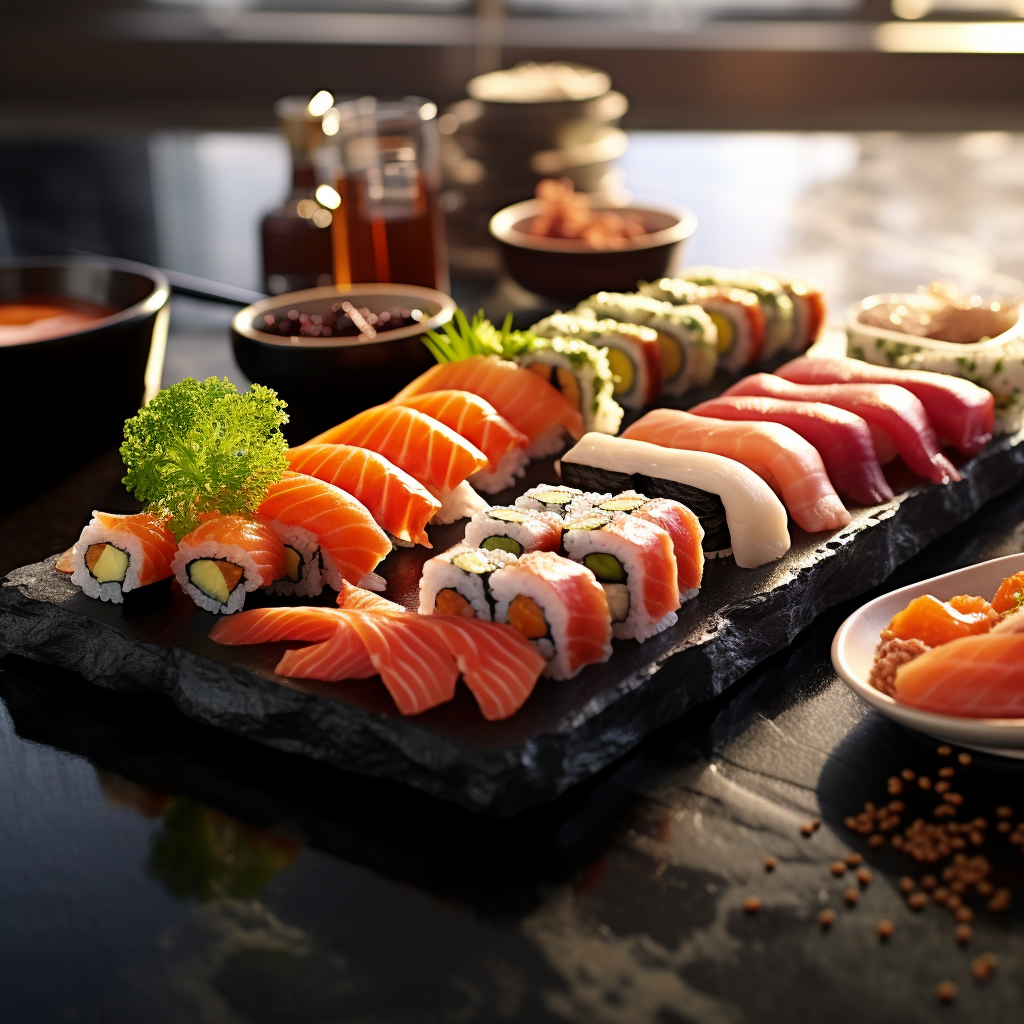Japanese sushi, a harmonious blend of vinegared rice and various toppings, has captivated the taste buds of food lovers worldwide. Often paired with a touch of wasabi and soy sauce, each bite into sushi can be an exhilarating taste adventure. Our fascination with japanese sushi isn’t just about the flavors; it’s also about the artistry and precision that go into making each piece.
Understanding sushi means appreciating its diversity – from the simplicity of nigiri to the creativity of modern rolls. As we explore this iconic Japanese cuisine, we’ll uncover not only the traditional practices but also the modern twists that keep japanese sushi evolving. Whether it’s the freshness of the seafood, the subtle tang of the rice, or the way it’s all put together, sushi has a way of bringing us together, fostering a shared experience over a meal that’s steeped in centuries of tradition.
The Birth of Japanese Sushi: History and Origins
We’re often intrigued by how our favorite dishes came to be, and Japanese sushi has a particularly captivating beginning. It’s a journey from necessity to an art form that has entranced food lovers worldwide.
From Fish Preservation to Delicacy: The Early Days of Japanese Sushi

Originally, sushi emerged not as the delicacy we know today, but as a way of preserving fish in fermented rice. This ancient technique dates back to the rice paddies of Southeast Asia, where fish was fermented with salt and rice, after which the rice was discarded and only the fish was eaten. This form of sushi is recognized as narezushi, and over time, it found its way to Japan.
Evolution and Edo-Period Sushi
Japanese Sushi underwent a significant transformation during the Edo period (1603–1868). It was in the 1800s in Edo, present-day Tokyo, when Japanese sushi began to resemble what we enjoy today. Stalls selling street food began offering nigiri-zushi, which is hand-pressed rice topped with a slice of fish, marking a shift to enjoying both rice and fish together. The advent of vinegar-flavored rice along with rapidly served nigiri coincided with the bustling lifestyle of Edo’s denizens, shaping sushi’s future as a fast, convenient, yet sophisticated meal.
Japan’s Geographical Influence on Sushi Culture

Japan’s geography has inarguably molded its sushi culture. Surrounded by oceans, it has access to a diverse range of seafood, a staple in sushi. The country’s mountainous terrain contributed to the development of localized rice cultivation, which is integral to japanese sushi. The variations in climate from north to south also affect the types of fish available and the regional sushi specialties that have developed over time. For example, the colder waters of northern Japan yield different types of seafood than those in the warmer southern waters, influencing local japanese sushi varieties.
Japanese Sushi Creations: A Variety for Every Palate

Japanese Sushi offers an array of tastes and textures, ensuring that there’s something special for everyone. We’re delighted to guide you through the exciting varieties of sushi.
Nigiri

Nigiri is a beloved type of sushi featuring a slice of raw fish over pressed vinegared rice. It’s a pure, simple way to enjoy the delicate flavors of fish like salmon and tuna.
Maki

Maki rolls are sushi classics, wrapping rice and fillings in seaweed. Choices range from cucumber maki to more elaborate dragon rolls, which might feature eel or avocado.
Sashimi

Sashimi, often confused with sushi, is actually just thinly sliced raw fish or meat, with no rice. It’s perfect for those who want to appreciate the ingredient’s flavor fully, such as the rich taste of fatty Bluefin tuna belly.
Chirashi

Chirashi is a bowl of vinegared rice topped with a medley of fish, garnishes, and additional ingredients, creating a colorful and diverse experience in each bite.
Temaki

Temaki is a hand-rolled cone of seaweed filled with rice, fish, and vegetables. It’s a casual, fun way to enjoy sushi and often features ingredients like spicy tuna or sweet potato.
Hey you! are you interested in beautiful food? Then you have to take a look at the following article: You definitely can’t miss it!
Masterful Craftsmanship: Sushi Preparation in Perfection

When we talk about Japanese sushi, we’re diving into a world where precision meets passion, creating an art form that tantalizes the senses.
The Role of Sushi Masters: Jiro and His Colleagues
The term “Itamae,” which translates to “in front of the board,” represents more than a sushi chef; it signifies a lifelong dedication to the mastery of sushi. Esteemed figures like Jiro Ono set a soaring standard of excellence. The documentary about Jiro Ono reveals that being a sushi master is about ceaseless improvement and regimented discipline. These artisans spend years, sometimes decades, learning the intricate balance of flavor, texture, and presentation that defines iconic japanese sushi.
Secrets of Preparation: From Rice Selection to Fish Quality

Rice Selection: Perfect japanese sushi begins with selecting the right rice. It’s not just about the grain; it’s the careful seasoning with vinegar mixture that creates the perfect shari (sushi rice).
Fish Quality: The fish must be nothing but the best. Sushi masters go to great lengths, choosing only the freshest and highest quality neta (topping), often sourced from the early morning markets.
The connection between these elements—the rice and the fish—is a subtle interplay that can only be mastered through years of experience. Visit the website of reismatte.de for insights on the evolution of sushi through its diverse forms, and how the meticulous preparation of each component plays a critical role in the art of sushi.
Japanese Sushi Culture: More Than Just Eating
When we think about Japanese sushi, we often picture beautifully crafted rolls and delicate nigiri pieces. But there’s so much more to explore beyond these delicious bites.
The Importance of Presentation: Sushi as a Visual Artwork

Sushi chefs are true artisans; they know that we eat with our eyes first. The arrangement of sushi on a plate is purposeful, offering a feast for the eyes before a single flavor touches your tongue. From the perfectly sliced fish to the elegant garnishes, each element is placed with intention, creating an edible canvas that reflects the culinary treasure of Japanese culture.
Flavor Explosions: Sushi and the Pleasures of the Senses
A single bite of sushi can be a symphony of flavors. Our senses of taste and smell work together, experiencing the fresh, briny scent of the ocean, the tang of vinegar in the rice, a hint of sweetness from the fish or a dab of wasabi, and even the satisfying texture. It’s a complete sensory experience that can transform a simple meal into a memorable one.
The Significance of Sushi in Japanese Society

In Japan, sushi is not just another item on the menu; it’s a symbol of tradition and pride. Sushi-making is an art that requires years of training, and it’s reflective of Japan’s cultural value of mastery and respect for ingredients. The role of sushi in Japan’s culinary identity is deep-seated, with each piece carrying a piece of history and innovation.
Sushi Etiquette: How to Eat Sushi in Traditional Ways
Did you know there’s a traditional way to enjoy japanese sushi? Whether using your hands or chopsticks, there’s etiquette to follow that enhances the experience. You might start with lighter flavors, move to richer ones, and never rub your chopsticks together – it’s considered rude! For a true sushi experience, etiquette is key, and it’s perfectly acceptable and even encouraged to eat sushi with your hands, especially when enjoying nigiri.
Enjoying Sushi at Home: Tips and Recipes for Home Chefs

When we think about Japanese Sushi, the image of skilled chefs and specialized restaurants often comes to mind. We’re here to guide you through creating these delicacies right in your own kitchen.
The Basics: Sushi Ingredients and Equipment
To embark on this culinary adventure, we need to gather the essential ingredients and equipment. At the heart of japanese sushi is the sushi rice; short-grained and seasoned with a mix of rice vinegar, sugar, and salt. You’ll want to have fresh, high-quality seafood such as salmon or tuna, and crisp vegetables like cucumber and avocado for the fillings. Nori sheets are crucial, as they hold everything together in rolls.
For equipment, a bamboo rolling mat helps in shaping perfect sushi rolls, while a sharp knife is essential for slicing your creation into bite-sized pieces. A rice cooker can be very useful, but it’s not absolutely necessary—you can cook the rice on the stovetop as well.
Step-by-Step Guide to Making Sushi at Home
Creating japanese sushi at home is a fun process that can be broken down into several steps. Start by washing the sushi rice until the water runs clear, then cook it according to instructions. Let the rice cool slightly before seasoning it with the vinegar mixture. While the rice cools, you can prepare your fillings, cutting them into strips that will fit easily in your rolls.
When you’re ready to assemble, place a sheet of nori on your bamboo mat, spread a thin layer of rice onto the nori, and then arrange your fillings across the rice. Using the mat, roll the nori tightly from one end to the other. Finally, cut the roll into six or eight pieces, and you’ve got homemade sushi ready to impress.
For more detailed instructions and recipe ideas, these guides on Best Sushi Recipes to Make At Home and 12 Tips For Making Homemade Sushi are incredibly helpful.
Health Aspects: Sushi as a Healthy Choice

When we think of Japanese Sushi, we often imagine a diverse palette of flavors, but it’s the balance of nutrition and the potential health benefits that truly makes it stand out as a healthy choice.
Nutritional Benefits
Sushi is a rich source of omega-3 fatty acids, particularly from fish like salmon and tuna. These fats are essential for our heart health and cognitive functions. Moreover, sushi provides a blend of proteins, carbohydrates, and a minimal amount of fats, making it well-rounded in terms of macronutrients.
- Proteins: With ingredients such as fish, tofu, and eggs, sushi is a great way to include lean protein in our diet.
- Carbohydrates: The sushi rice offers a quick energy source, thanks to its high glycemic index.
- Fats: The presence of avocados and fish in sushi rolls provides essential healthy fats.
Sushi as Superfood: Health Benefits of Sushi

Sushi can be considered a superfood due to its nutrient-dense ingredients. Seaweed, used in making sushi rolls, contains iodine which is crucial for thyroid health. The fish in sushi are packed with vitamins and minerals that are important for maintaining a healthy body.
- Vitamins and Minerals: Fish such as mackerel and tuna are high in vitamins D and B12.
- Antioxidants: Sushi garnishes like ginger and wasabi are not just for flavor—they’re packed with antioxidants.
Sushi and Sustainability: Environmental Considerations in the Sushi Industry
We must acknowledge that the sustainability of sushi is vital for both our health and the environment. The sourcing of fish affects the nutrient quality and the ecological impact of our sushi choices.
- Sustainable Sourcing: Opting for sushi made from sustainably caught or farmed fish ensures that we are not contributing to overfishing.
- Eco-friendly Practices: Supporting restaurants that adopt sustainable practices helps promote a healthier ecosystem.
Incorporating responsibly sourced sushi into our diet allows us to enjoy the health benefits of Japanese sushi while also taking care of our planet.
Sushi Worldwide: International Sushi Trends

As aficionados of Japanese Sushi, we’ve watched it transform and weave its way through cultures across the globe. It’s a culinary adventure that continues to evolve and surprise us.
Sushi Revolution: How Sushi Conquered the World
Sushi has undergone a meteoric rise from a traditional Japanese delicacy to a worldwide phenomenon. The Global Sushi Restaurants Market projects continual growth, indicative of sushi’s expanding popularity. Countries far and wide now enjoy sushi in various forms, from upscale restaurants to casual dining spots.
Creative Sushi Variations from Around the Globe

Globetrotters will find sushi that reflects local flavors and ingredients. In Brazil, sushi adapts to local tastes with tropical fruits, while in America, cream cheese and avocado became staples. These creative twists showcase sushi’s versatility and the integration into local cuisines.
Fusion Sushi Styles
The fusion of traditional japanese sushi with other cuisines leads to innovative sushi styles. Chefs are crafting unique flavor combinations, like spicy Latin-inspired rolls or incorporating classic French ingredients. This fusion sushi trend is a testament to sushi’s adaptability and its ever-changing nature.
Sushi Robots and Automation

As sushi’s popularity soars, technology in the kitchen does too. Sushi robots are emerging, enhancing efficiency and precision in sushi preparation. Despite some initial hesitation, these machines are becoming a common sight in many high-volume establishments, ensuring consistency in quality and presentation.
The Best Sushi Restaurants in Japan
When we think of Japanese sushi, we’re imagining the freshest, highest-quality ingredients crafted into an art form. Japan is home to some of the world’s most extraordinary sushi restaurants, catering to a range of tastes and experiences.
Top 5 Sushi Restaurants in Japan for the Ultimate Culinary Experience
- Sukiyabashi Jiro
- Location: Ginza, Tokyo
- Claim to Fame: A world-renowned sushi spot that has become famous for its Michelin-starred quality and the dedication of its master sushi chef, Jiro Ono.
- Unique Fact: Jiro Ono is often referred to as “sushi no kamisama” which means sushi god.
- More Information: Sukiyabashi Jiro in Ginza
- Sushi Saito
- Location: Minato, Tokyo
- Claim to Fame: Known for its intimate setting and is highly praised for the quality of its ingredients and the sushi mastery on display.
- Unique Fact: It holds a Michelin three-star rating and often requires reservations months in advance.
- More Information: Michelin-Starred Sushi Saito
- Sushi Yoshitake
- Location: Ginza, Tokyo
- Claim to Fame: Another Michelin three-star establishment showcasing the chef’s innovative approach to traditional sushi.
- Unique Fact: The chef, Masahiro Yoshitake, creates an unforgettable omakase experience.
- More Information: Sushi Yoshitake Experience
- Sushi Sho
- Location: Yotsuya, Tokyo
- Claim to Fame: Known for its “Sho-style” sushi which involves less traditional, more innovative combinations.
- Unique Fact: The head chef, Keiji Nakazawa, is renowned for his unique style of sushi that pairs unusual ingredients.
- More Information: Sushi Sho Innovations
- Hakkoku
- Location: Ginza, Tokyo
- Claim to Fame: A favorite among locals and tourists alike, offering a sublime sushi encounter.
- Unique Fact: This eatery is praised for presenting a personalized sushi course tailored to each diner.
- More Information: Hakkoku Tailored Courses
Frequently Asked Questions
What is the difference between Nigiri and Sashimi?
Nigiri consists of bite-sized portions of vinegared rice topped with various ingredients, often including fish, while Sashimi refers to thin slices of raw fish or seafood served without rice. The key distinction is that Nigiri includes rice, while Sashimi does not.
What is the significance of the sushi chef’s knife skills?
The sushi chef’s knife skills are crucial in ensuring precision and freshness in sushi preparation. Their ability to slice fish thinly and evenly affects the texture and taste of the sushi. A well-trained sushi chef’s knife skills are a hallmark of quality sushi.
Is it okay to dip sushi in soy sauce completely?
No, it’s not advisable to dip sushi completely into soy sauce. Instead, lightly dip only the topping (fish or seafood) into the soy sauce to enhance the flavor without overwhelming the delicate taste of the rice. Dipping rice can cause it to break apart and absorb too much soy sauce, affecting the balance of flavors.
If you liked this blog post about japanese sushi, don’t forget to leave us a comment down below and follow us on Pinterest! Write us what is your absolute Favorite of japanese sushi!


